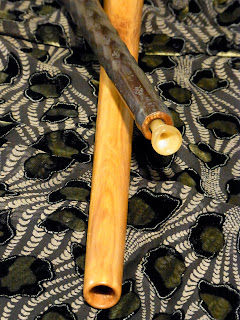Cornetto&Cornetto muto
コルネットの由来は、中世の信号用に使用された角笛であると考えられています。15世紀末頃には木管楽器に進化し、角製、または木製のマウスピースを持つ曲がった、もしくは直管型コルネットと、マウスピースと一体になったミュートコルネットの2つのタイプが登場します。一般にコルネットは柔らかいながらも、音量のある力強い音色を持っていますが、ミュートコルネットは音質が非常に柔らかく、深みがあり、歌曲等で声に重ねて演奏される事も多々あります。 ソプラノ楽器として発展したコルネットの黄金時代は16世紀後半に始まり、ヴァイオリンと肩を並べるソロ楽器として、主にイタリアやドイツで活躍しました。コルネットの演奏を耳にした人々の文献や手紙には、その楽器の魅力、奏者の卓越した技術が記されています。16世紀イタリアの偉大な彫金師、ヴェンヴェヌート・チェッリーニは彼の自伝の中でこのように語っています。「・・・ときどきではあるが私はコルネットをもちだすと、内気で憂いに満ちた表情をしているその少年の顔はたちまちほころび、その汚れの無い美しい笑顔は、ギリシャ人に描写される天の神々の物語を、少しも驚くべきものだとは思わせないのである。」
It is thought that the cornett originated from an animal horn which would have been used for communicating signals in the middle ages. By the 15th century it had evolved into the wooden cornett, of which there are two types. The cornett is curved(or straight) with separate mouthpiece, while the Mute cornett is straight with the mouthpiece an integral part of the instrument.Although both cornetts have a soft sound, the cornett has a clear and more powerful sound, while the mute cornett has a softer and more profond sound giving it an affinity with vocal music.
Theorbo&Lute
 そもそも中近東の発弦楽器、ウードが中世時代に東はシルクロードを渡り、中国、日本に伝わって現在の琵琶に姿を変えていますが、西ヨーロッパではリュ-トに発展しました。 イギリスやフランス、イタリアなどヨーロッパ各国でソロ楽器、また、アンサンブルや声楽曲の伴奏楽器として大活躍したリュートですが、もともと15,16世紀には6コース(1コースのみ単弦で2コース以下は複弦)だったルネッサンス・リュ-トも年代が進み、低音部の充実が要求された為、7コース、8コースと低音弦が増やされました。 17世紀に入るとさらに弦の数が増え、アーチリュートという楽器も出現しました。 また、リュ-ト族の中でも特に17世紀初期にイタリアで大活躍したのがテオルボです。 16世紀終わり頃に発明されたこの楽器は、ソロ楽器としてはもちろんのこと、低音部の弦長が150センチを超えるような大型のテオルボは声楽曲の伴奏や大編成のオーケストラ(特にオペラなど)の中で演奏するために大変、重宝されました。楽器の指定がされている楽譜も多く出版され、カッチーニは彼の声楽曲集「Le Nuove Musiche](1601)の序文の中で、テオルボとテノールの声との相性について絶賛しています。
そもそも中近東の発弦楽器、ウードが中世時代に東はシルクロードを渡り、中国、日本に伝わって現在の琵琶に姿を変えていますが、西ヨーロッパではリュ-トに発展しました。 イギリスやフランス、イタリアなどヨーロッパ各国でソロ楽器、また、アンサンブルや声楽曲の伴奏楽器として大活躍したリュートですが、もともと15,16世紀には6コース(1コースのみ単弦で2コース以下は複弦)だったルネッサンス・リュ-トも年代が進み、低音部の充実が要求された為、7コース、8コースと低音弦が増やされました。 17世紀に入るとさらに弦の数が増え、アーチリュートという楽器も出現しました。 また、リュ-ト族の中でも特に17世紀初期にイタリアで大活躍したのがテオルボです。 16世紀終わり頃に発明されたこの楽器は、ソロ楽器としてはもちろんのこと、低音部の弦長が150センチを超えるような大型のテオルボは声楽曲の伴奏や大編成のオーケストラ(特にオペラなど)の中で演奏するために大変、重宝されました。楽器の指定がされている楽譜も多く出版され、カッチーニは彼の声楽曲集「Le Nuove Musiche](1601)の序文の中で、テオルボとテノールの声との相性について絶賛しています。
The first plectrum instrument in the middle and near est was the 'oud' which teavelled over asia through the silk road in the middle ages, eventually becoming the 'biwa' in Japanese or 'pipa' in Chinese.In Westerneurope the'oud' developed into the lute flourishing as a solo instrument and as an accompaniment of vocal music in many countries.In 15&16th centuries the lute had six courses but in order to enrich the lower resister the number of courses gradually increased culminating in the archlute at the beginning of the 17 century.The theorbo was invented at the end of 16th century and quickly became popular as both a solo and continuo instrument, especially for the accompaniment of opera and large vocal and ensemble works.


